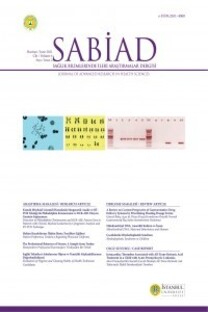Esra Esmeray SÖNMEZ,
Tevfik HATİPOĞLU,
Xiaozhou HU,
Hongling YUAN,
Ayça ERŞEN DANYELİ,
Ayla ANAR ARICI,
Ahmet ŞEYHANLI,
Zühal ÖNDER SİVİŞ,
Bengü DEMİRAĞ,
Eda ATASEVEN,
Dilek İNCE,
Zekiye ALTUN,
Safiye AKTAŞ,
İnci ALACACIOĞLU,
Tuğba SÜZEK,
Nazan ÖZSAN,
Taner Kemal ERDAĞ,
Elvan Caglar CİTAK,
Sermin ÖZ
126112
THERAPEUTIC IMPLICATIONS OF TARGETED SEQUENCING AND miRNA-SEQ OF B CELL LYMPHOMAS
Objective: Next-generation sequencing (NGS)-based approaches facilitated the identification of genomic and transcriptomic alterations associated with the development of B-cell lymphomas. Identification of these aberrancies during diagnosis may be helpful in choosing the most appropriate targeted therapy. Follicular lymphoma and Burkitt lymphoma are B-cell non-Hodgkin lymphomas with the potential to benefit from molecular targeted therapy. Materials and Methods: Targeted sequencing or miRNA-Seq were performed on FFPE tumor tissues of FL and pediatric BL (pBL) cases, respectively, using the HiSeq system. Cancer- associated somatic mutations were identified in FL tumor tissue DNA samples through a computational bioinformatics pipeline. miRNAs overexpressed in pBL cases compared with the tonsil centroblasts of non-cancer control cases were identified through differential expression analyses. Sanger sequencing or qRT-PCR were used to cross-validate targeted NGS and miRNA-Seq results, respectively. The literature search was performed to evaluate the therapeutic potential of these somatic mutations and upregulated miRNAs. Results: Targeted sequencing of FL tumor tissues revealed activating mutations in genes of biological processes or oncogenic signaling pathways. Several miRNAs were identified to be significantly overexpressed in pBL cases. The literature search revealed that targeted therapeutic approaches may be available for the FL or pBL patients with the identified mutations or upregulated miRNAs in tumor tissues. Conclusion: Targeted NGS may be applied during diagnosis to choose appropriate therapy for FL patients. Upregulated miRNAs provide unique opportunities for personalized targeted therapy of pBL patients.
THERAPEUTIC IMPLICATIONS OF TARGETED SEQUENCING AND miRNA-SEQ OF B CELL LYMPHOMAS
Objective: Next-generation sequencing (NGS)-based approaches facilitated the identification of genomic and transcriptomic alterations associated with the development of B-cell lymphomas. Identification of these aberrancies during diagnosis may be helpful in choosing the most appropriate targeted therapy. Follicular lymphoma and Burkitt lymphoma are B-cell non-Hodgkin lymphomas with the potential to benefit from molecular targeted therapy. Materials and Methods: Targeted sequencing or miRNA-Seq were performed on FFPE tumor tissues of FL and pediatric BL (pBL) cases, respectively, using the HiSeq system. Cancer- associated somatic mutations were identified in FL tumor tissue DNA samples through a computational bioinformatics pipeline. miRNAs overexpressed in pBL cases compared with the tonsil centroblasts of non-cancer control cases were identified through differential expression analyses. Sanger sequencing or qRT-PCR were used to cross-validate targeted NGS and miRNA-Seq results, respectively. The literature search was performed to evaluate the therapeutic potential of these somatic mutations and upregulated miRNAs. Results: Targeted sequencing of FL tumor tissues revealed activating mutations in genes of biological processes or oncogenic signaling pathways. Several miRNAs were identified to be significantly overexpressed in pBL cases. The literature search revealed that targeted therapeutic approaches may be available for the FL or pBL patients with the identified mutations or upregulated miRNAs in tumor tissues. Conclusion: Targeted NGS may be applied during diagnosis to choose appropriate therapy for FL patients. Upregulated miRNAs provide unique opportunities for personalized targeted therapy of pBL patients.
___
- Grozescu T, Popa F. Prostate cancer between prognosis and adequate/proper therapy. J Med Life. 2017;10(1):5-12
